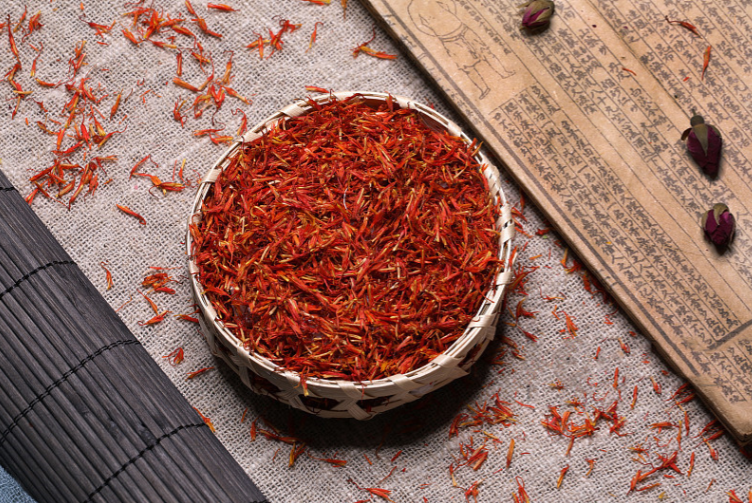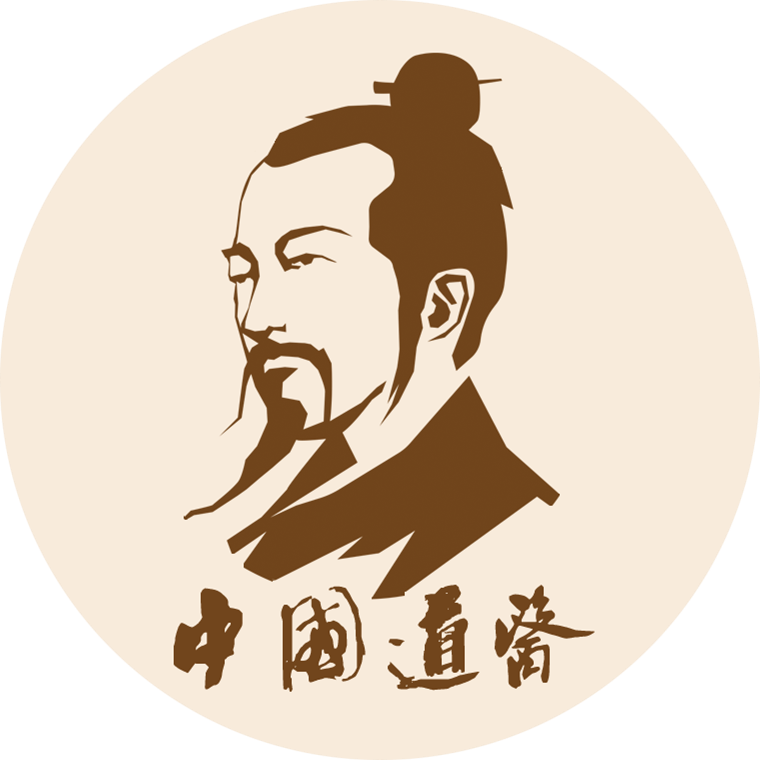
1. Alias
Safflower, Red Flower, Thistle Flower.
2. Plant Morphology
Annual herb. Height 40–100 cm. Stem erect, branched at the top, with fine shallow grooves on the surface. Hairless. Leaves alternate; nearly without petioles, slightly clasping the stem; leaf blades are long oval or ovate-lanceolate. Capitulum inflorescence terminal, 2–3 cm in diameter, arranged in an umbrella shape; involucre nearly spherical, with several whorls of involucral bracts, the outer 2–3 whorls leaf-like with serrated edges, the inner several whorls ovate, with smooth edges, white membranous, transparent, and the innermost whorl linear scale-like, transparent and membranous; many flowers, growing on a flat receptacle, all tubular, orange-red, about 2 cm long; corolla tube slender, with 5 lobes at the tip; 5 stamens, short filaments, attached at the mouth of the corolla, anthers linear, fused into a tube surrounding the pistil; 1 pistil, with a long style extending outside the anther tube, and the stigma bifid. Achene obovate, with 4 ridges, slightly slanted at the base. Flowering period from May to July, fruiting period from July to September.
3. Distribution
Originally from Egypt, widely cultivated in China.
4. Harvesting and Processing
Harvest tubular flowers in May to June when they change from yellow to red, in the morning before the dew dries, taking care to protect the ovaries for seed development. Dry the flowers in weak sunlight or in the shade, or can be dried with low heat.
5. Medicinal Properties
Tubular flowers without ovaries, 1–2 cm long. Surface red-yellow or red. Corolla tube long and slender, with 5 lobes at the tip, lobes narrow and 5–8 mm long; 5 stamens, anthers fused into a tubular structure, yellow-white; stigma long oval, slightly bifid at the tip. Soft texture. Slightly fragrant, with a slightly bitter taste.
6. Nature and Taste
Warm in nature, pungent in taste. Enters the Heart (Xin) and Liver (Gan) meridians.
7. Effects and Functions
Invigorates blood circulation, regulates menstruation, disperses blood stasis, and alleviates pain. Classified as a blood-activating and stasis-dispelling herb.
8. Clinical Applications
Dosage of 3–9 grams, decocted for oral administration. Used to treat amenorrhea, dysmenorrhea, retained lochia, abdominal masses, traumatic injuries, and painful swellings.
9. Pharmacological Research
Exhibits mild cardiac stimulation, reduces coronary resistance, increases coronary flow and myocardial nutritive blood flow; anti-myocardial ischemia, myocardial infarction, arrhythmia; improves peripheral microcirculation; anticoagulant; lowers blood lipids; enhances hypoxia tolerance; stimulates the uterus; relieves intestinal spasms; possesses immunological activity and anti-inflammatory effects; alleviates metabolic disorders of monoamine neurotransmitters in brain tissue; may cause mutations. Animal experiments indicate that small doses of the decoction stimulate the heart, while large doses have an inhibitory effect; it has a significant direct constrictive effect on blood vessels; safflower yellow pigment significantly prolongs the survival time of mice in hypoxic environments; it has a notable inhibitory effect on ADP-induced platelet aggregation; and exhibits analgesic properties.
10. Chemical Composition
Contains safflower glycoside, new safflower glycoside, pre-safflower glycoside, safflower quinone glycoside, hentriacontane, β-sitosterol, and other components such as dipalmitic acid, glycerides, oleic acid, linoleic acid, chlorogenic acid, totaling 13 components. Additionally, it has been reported to contain safflower yellow pigment.
11. Contraindications
Use with caution in pregnant women and those with excessive menstruation.
12. Compatible Formulas
① For dysmenorrhea: 6 grams of safflower, 24 grams of chicken blood vine. Decoct and mix with an appropriate amount of yellow wine for consumption. (“Fujian Materia Medica”)
② For women with obstructed menstruation, such as blood stasis: safflower (finely chopped), sappan wood (crushed), and angelica in equal parts: each 30 grams, with 1.5 liters of water, first decoct the flowers and wood. Then add a cup of wine and angelica and decoct again. Take half a liter, divided into two doses, on an empty stomach before meals, warm. (“Zhu’s Collected Proven Formulas” Safflower Powder)
③ For cough with reversed menstruation and shortness of breath: safflower, scutellaria, sappan wood each 2.4 grams, tianhua fen 1.8 grams. Decoct and take on an empty stomach. (“Bamboo Forest Gynecology” Safflower Decoction)
④ For cervical cancer: 6 grams of safflower, 6 grams of alum, and 30 grams of ephedra. Decoct, first fumigate then wash the external genitalia, once or twice daily for 30–60 minutes each time, reheat for reuse, each dose can be used repeatedly for 3–4 days. [“Shanghai Journal of Traditional Chinese Medicine” 1984, (9): 9]
⑤ For initial swelling and pain that is unbearable: safflower, pangolin (fried) each 15 grams, and 9 grams of angelica tail. Two cups of yellow wine, decoct to one cup. Mix with 1.5 grams of ferula and 0.15 grams of musk for consumption. (“Surgical Great Achievements”)
⑥ For red swelling and half-body redness that gradually spreads: safflower powder, mixed with vinegar for external application. (“General Discussion on Pediatric Hygiene”)
⑦ For chronic ear discharge with foul odor: 0.3 grams of safflower, 30 grams of alum (burnt to ash). Grind the above medicine into a fine powder, use a small amount in the ear. (“Shenghui Formulas”)






Daoist Medical Video Account
⊙ The content of this article is for clinical reference only; non-TCM professionals should not attempt to use these herbs.
⊙ Some images and texts are sourced from the internet; please contact us for removal if there is any infringement.
⊙ For Daoist medical consultations, add WeChat ID: daoxuea
⊙ For submissions and collaborations: [email protected] (original submissions are welcome)
Selected Articles
❶ Want to have good fortune in 2023? Don’t forget to welcome the God of Wealth on the fifth day of the Lunar New Year!
❷ What you are losing is not hair, but Qi and blood! A small formula to solve white hair and hair loss!
❸ Daoist cultivation guidance: It is difficult to achieve the dual cultivation of life and nature without refining the true Qi of Taiyi!
❹ Pat your body 20 times, and your cough will be gone the next day! It’s that miraculous!
❺ Daily learning of Traditional Chinese Medicine: Osmanthus!
❻ TCM: Don’t be afraid if you test positive; patting here can greatly improve discomfort symptoms!
❼ Rural saying: A handful of yellow beans “detoxifies”! Must eat often during the pandemic!
❽ The most suitable alchemical practice for modern people, the method of innate Qi!
❾ “Cold dampness” is the “root of poison”! A mysterious acupoint can transform “the ice and snow within the body” into “great primal power”!

 Scan to follow Daoist Medicine
Scan to follow Daoist Medicine
Here, there are no chicken soup, folk prescriptions, rumors, or advertisements, only reliable Daoist health and wellness knowledge.


